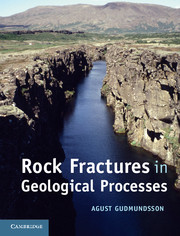Book contents
- Frontmatter
- Contents
- Preface
- Acknowledgements
- 1 Introduction
- 2 Stress
- 3 Displacement and strain
- 4 Relation between stress and strain
- 5 Loading of brittle rocks to failure
- 6 Stress concentration
- 7 Theories of brittle failure of rocks
- 8 Extension fractures and shear fractures
- 9 Displacements and driving stresses of fractures
- 10 Toughness and fracture mechanics
- 11 Field analysis of extension fractures
- 12 Field analysis of faults
- 13 Evolution of extension fractures
- 14 Evolution of faults
- 15 Fluid transport in rocks – the basics
- 16 Fluid transport in faults
- 17 Fluid transport in hydrofractures
- Appendix A Units, dimensions, and prefixes
- Appendix B The Greek alphabet
- Appendix C Some mathematical and physical constants
- Appendix D Elastic constants
- Appendix E Properties of some crustal materials
- Index
- References
13 - Evolution of extension fractures
Published online by Cambridge University Press: 05 June 2012
- Frontmatter
- Contents
- Preface
- Acknowledgements
- 1 Introduction
- 2 Stress
- 3 Displacement and strain
- 4 Relation between stress and strain
- 5 Loading of brittle rocks to failure
- 6 Stress concentration
- 7 Theories of brittle failure of rocks
- 8 Extension fractures and shear fractures
- 9 Displacements and driving stresses of fractures
- 10 Toughness and fracture mechanics
- 11 Field analysis of extension fractures
- 12 Field analysis of faults
- 13 Evolution of extension fractures
- 14 Evolution of faults
- 15 Fluid transport in rocks – the basics
- 16 Fluid transport in faults
- 17 Fluid transport in hydrofractures
- Appendix A Units, dimensions, and prefixes
- Appendix B The Greek alphabet
- Appendix C Some mathematical and physical constants
- Appendix D Elastic constants
- Appendix E Properties of some crustal materials
- Index
- References
Summary
Aims
How do small extension fractures link to form larger fractures? More specifically, what main factors determine the path of an extension fracture? These topics are of great importance in understanding the development and maintenance of permeability in crustal rocks and reservoirs. The topic is also fundamental in understanding how volcanoes work. This follows because most volcanic eruptions are supplied with magma through dykes and inclined sheets, both of which are extension fractures. For assessing volcanic hazards and risks, we need to understand how dykes and sheets propagate to the surface, resulting in an eruption, or, alternatively, become arrested within layers or at layer contacts or other discontinuities. The main aims of this chapter are to present results on the:
General development of tension fractures.
General propagation and path-selection of hydrofractures.
Conditions for hydrofracture deflection and arrest.
Apertures of hydrofractures subject to constant fluid overpressure.
Apertures of hydrofractures subject to varying fluid overpressure.
Surface deformation related to arrested hydrofractures.
Development of tension fractures
Tension fractures develop in a similar way to hydrofractures. Most of the conclusions regarding hydrofracture propagation, deflection, and arrest, presented below, apply, with modifications, to tension fractures as well. The main differences are, first, that large tension fractures are restricted to shallow crustal depths, usually the uppermost 0.5–1 km of the crust (Chapters 7 and 8). Second, tension fractures are driven by external tensile stress, whereas hydrofractures are driven by internal fluid overpressure.
- Type
- Chapter
- Information
- Rock Fractures in Geological Processes , pp. 373 - 415Publisher: Cambridge University PressPrint publication year: 2011
References
- 2
- Cited by



